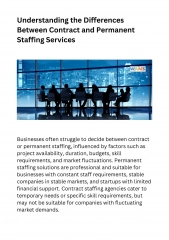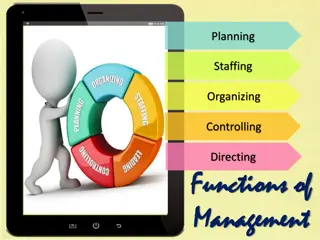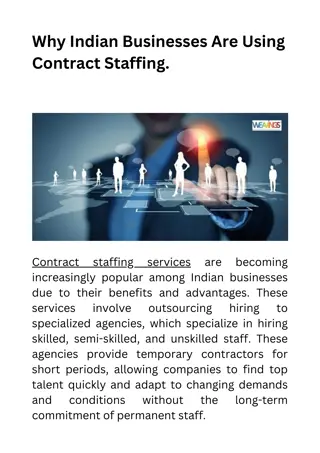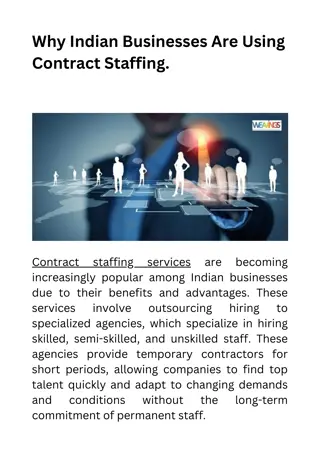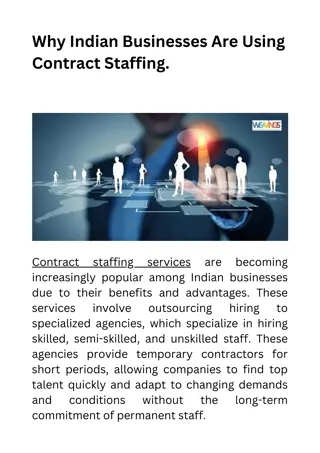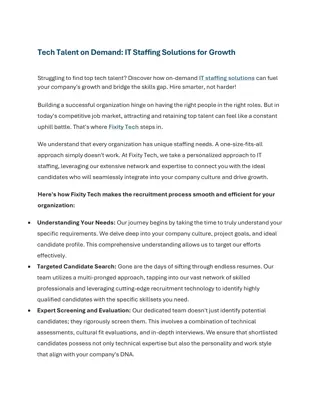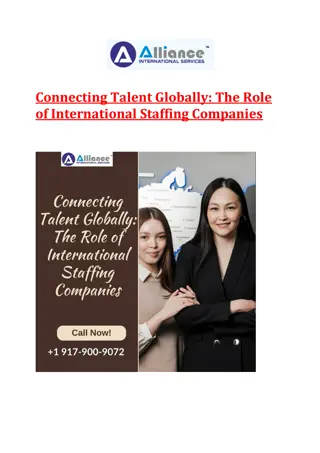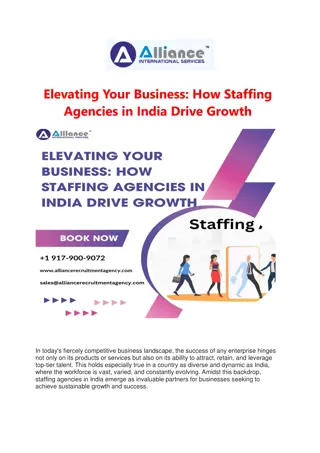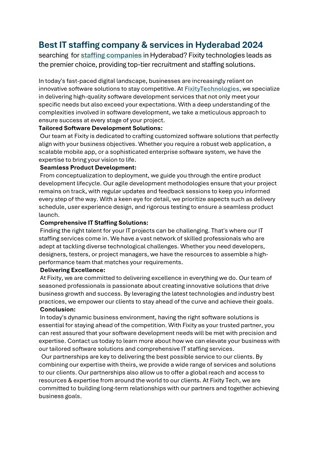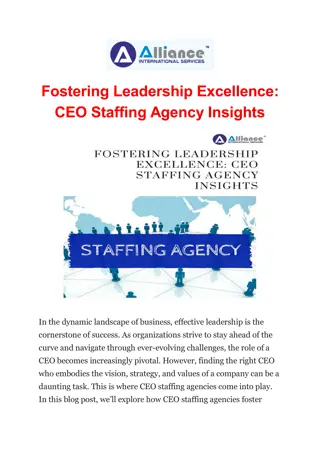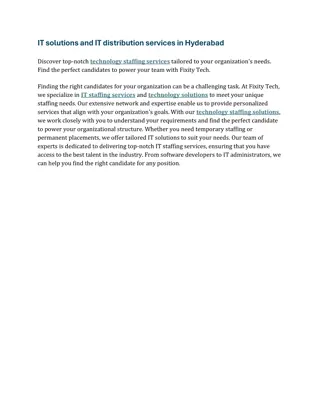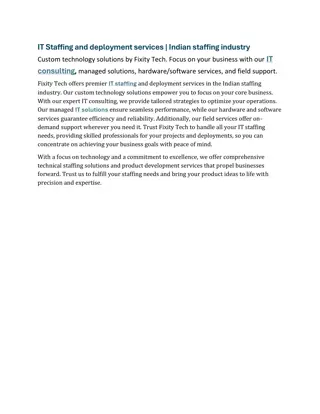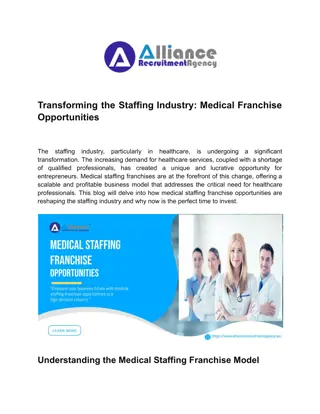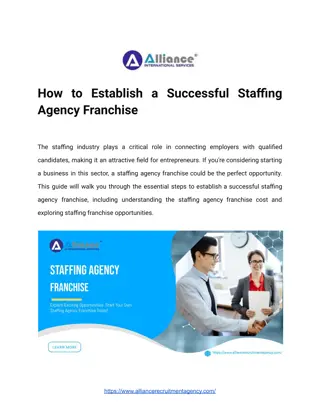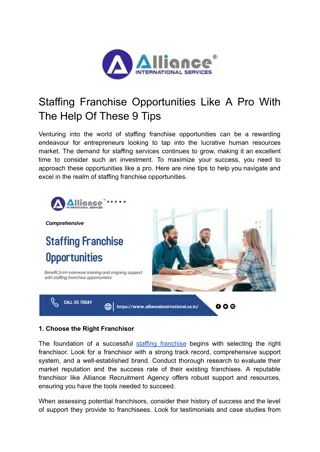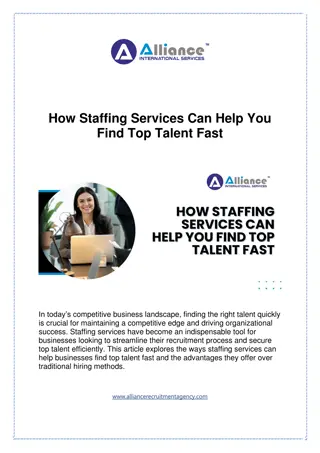
Importance of Staffing in Organizations
Staffing is a crucial process in organizations that involves recruiting, evaluating, and placing employees in suitable roles. It ensures the right people are hired for the right jobs, leading to improved productivity, job satisfaction, and organizational growth. Learn more about the significance and functions of staffing in this detailed guide.
Download Presentation

Please find below an Image/Link to download the presentation.
The content on the website is provided AS IS for your information and personal use only. It may not be sold, licensed, or shared on other websites without obtaining consent from the author. If you encounter any issues during the download, it is possible that the publisher has removed the file from their server.
You are allowed to download the files provided on this website for personal or commercial use, subject to the condition that they are used lawfully. All files are the property of their respective owners.
The content on the website is provided AS IS for your information and personal use only. It may not be sold, licensed, or shared on other websites without obtaining consent from the author.
E N D
Presentation Transcript
Dr Digvijay Sharma School of health sciences
Definitions Staffing is the process of hiring eligible candidates in the organization orcompany for specific positions. In management, the meaning of staffing is an operation of recruiting the employees by evaluating their skills, knowledge and then offering them specific job roles accordingly
Definitions In management, staffing is an operation of recruiting the employees by evaluating their skills and knowledge before offering them specific job roles accordingly.[1]
It is a truth that human resource is one of the greatest for every organization because in any organization all other resources like- money, material, machine etc. can be utilized effectively and efficiently by the positive efforts of human resource.
Therefore it is very important that each and every person should get right position in the organization so as to get the right job, according to their ability, talent, aptitude, and specializations,so that it will help the organization to achieve the pre-set goals in the proper way by the 100% contribution of manpower. Thus it can be said that, staffing is an essential function of every business organization.
Functions of Staffing To obtain qualified personnel for different jobs position in the organization. To recruit right person for the right jobs, therefore it leads to maximum productivity and higher performance. To promote the optimum utilization of human resource through various aspects. To provide Job satisfaction and boost morale of the workers through the recruitment of the right person. To ensure better utilization of human resources. To ensures the continuity and growth of the organization, through development managers.
Importance Staffing helps to find and hire people who are qualified for the job position and will benefit the company. It also improves the quality and quantity of work done by the company because they have staffed the optimum people.
Job satisfaction Job satisfaction rates are likely to increase because everyone is well-suited for their position and is happy to be doing their specialty of work. Higher rates of productive performance from the company are also common, as they have staffed the right people to do their jobs. It provides employees the opportunity for further growth and development.[5]
Characteristics of Staffing
People-Centered Staffing can broadly viewed as people-centered function and therefore it is relevant for all types of organization. It is concerned with categories of personnel from top to bottom of the organization. Blue collar workers (i.e., those working on the machines and engaged in loading, unloading etc.) and white collar workers (i.e., clerical employees). Managerial and Non Managerial personal. Professionals (eg.- Chartered Accountant, Company Secretary)
Responsibility of Manager Staffing is the basic function of management which involves that the manager is continuously engaged in performing the staffing function. They are actively associated with the recruitment, selection, training, and appraisal of his subordinates. Therefore the activities are performed by the chief executive, departmental managers and foremen in relation to their subordinates.
Human Skills Staffing function is mainly concerned with different types of training and development of human resource and therefore the managers should use human relation skill in providing guidance and training to the subordinates. If the staffing function is performed properly, then the human relations in the organization will be cordial and mutually performed in an organized manner.
Continuous Function Staffing function is to be performed continuously which is equally important for a new and well-established organization. Since in a newly established organization, there has to be recruitment, selection, and training of personnel. As we compare that, the organization which is already a running organization, then at that place every manager is engaged in various staffing activities. Therefore, he is responsible for managing all the workers in order to get work done for the accomplishment of the overall objectives of an organization.
Core staffing activities The five core staffing activities are:- recruitment Selection employment training retaining
Recruitment Herbert Heneman has described an effective recruiting process as the cornerstone of an effective staffing system.[2] Job analysis involves the collection of information about jobs in the organization (not the persons holding the jobs). As such, the analysis focuses on duties, responsibilities, knowledge, skills, and other characteristics required to perform the job.[3] As part of the recruiting process, the organization will have to decide to recruit internally or externally. Internal recruiting is when an organization intends to fill a vacancy from within its existing workforce. External recruitment is when an organization looks to fill vacancies from applicants outside of the company.
Selection Selection is an important part of the staffing process, and if done wrong, the organization could lose candidates. The purpose of the selection process is to determine whether a candidate is suitable for employment in the organization or not.[4]This process starts with the review of the job applications, r sum s, and cover letters of the job candidates. The organization then gives an initial interview to eliminate the unqualified candidates. The next steps are to reduce the candidates to get the finalist for the job. This includes testing, structured interview and contingent assessment. The testing can include personality, ability, and intelligence tests. A structured interview has specific questions to ask and is given by somebody within the organization familiar with the position. The contingent assessment is the last step, and it includes drug tests and medical exams.
Employment Employment is the process of hiring the individual who was selected in the section process. The organization should first propose a job offer, which typically includes starting date, duration of the contract, compensation, starting rate, benefits, and hours of the position. The organization then prepares for the new employee s arrival. Ideally, the company should make sure that the employee has all of the tools required to do their job effectively, such as security badges, keys, and any other technology.[5]
Training After the selection of an employee, the employee receives training. With the various technological changes in modern history, the need for training employees is increased to keep the employees in touch with the various new developments.[6]Staffing can be influenced by how staffers are trained and the type of training they receive. Training is generally classified into two types, on the job and off the job. Some examples of training programs include:[7] Technical training training that teaches employees about a particular technology or a machine. Quality training trains employees to identify faulty products. Skills training training that is given to employees to perform their particular jobs. Soft skills personality development Team training training establishes a level of trust and synchronicity between team members for increased efficiency.
Retaining Employees can leave jobs for a variety of different reasons. Employers should listen to the needs of their employees and make them feel valued. Employers need to create a positive work culture and motivating practices into their organization to keep employees. Retention methods have a positive impact on the organization s turnover rate. Benefits can include training, positive culture, growth opportunities within the organization, trust and confidence in leaders, and lower stress from overworking.[8]
Staffing agencies Staffing agencies are becoming more common because of their ease of use and low cost. Companies save a lot of money through using a staffing agency because theydo not have to spend extra money on employee recruitment or fund any of the screenings new hires must undergo. Using a staffing agency eliminates the need for companies to do extensive advertisements about the positions they are hiring for. The agencies save time by avoiding having to spend a large amount of time searching for applicants and recruiting new people. Staffing agencies provide a large network of job candidates, so it is easy to find people to fill the jobs. They have many tools and the knowledge to find the perfect applicants for the jobs each company needs to fill. If a company has an unexpected need to fill a position, a staffing agency can usually quickly find someone.[9][10][11]
Refrences 1. "Staffing - Definition, Meaning, Functions, Importance, Videos". Toppr-guides. 2018-03-25. Retrieved 2020-02-22. 2. Heneman, Herbert G., III (12 February 2014). Staffing organizations. Judge, Tim; Kammeyer-Mueller, John (Eighth ed.). Mishawaka, IN. 3."Organizational Staffing and Career Development - IResearchNet". Career Research. 2015-01-29. 4. "Staffing Process - Steps for Management, Benefits, Questions and Videos". Toppr-guides. 2018-06-25. 5. "Tips and Tricks for Staffing Your Business". business.com. Retrieved 2020-04-17. 6. "Staffing Process - Steps for Management, Benefits, Questions and Videos". Toppr-guides. 2018-06-25. 7. "Training and Development: Training Methods, Benefits of Training". Toppr-guides. 2018-12-25. 8. "Strategies for Retaining Employees and Minimizing Turnover". hr.blr.com. 9. Recruiting, Crawford Thomas. "The Benefits of Staffing - Crawford Thomas Recruiting. 10. "American Staffing Association". American Staffing Association. 11. "What is Staffing? How staffing solutions helps". Exato Software. 12. Staffing: Definition, Meaning, and Functions . https://www.toppr.com/guides/business-studies/staffing.

